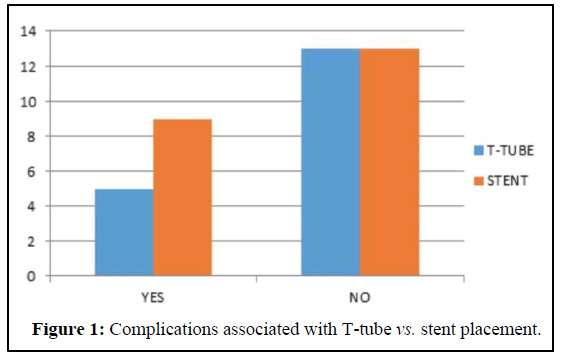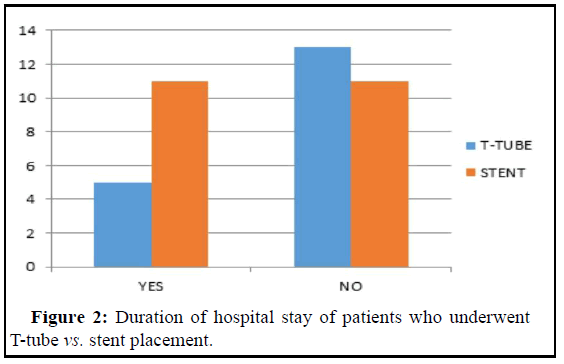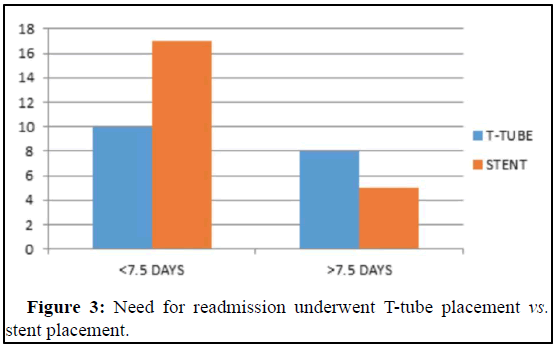A Comparative Study between T-Tube Drainage vs. Stent in Open CBD Exploration
Received: 21-Apr-2023 / Manuscript No. JGDS-23-96748 / Editor assigned: 24-Apr-2023 / PreQC No. JGDS-23-96748 (PQ) / Reviewed: 08-May-2023 / QC No. JGDS-23-96748 / Revised: 21-Jun-2023 / Manuscript No. JGDS-23-96748 (R) / Published Date: 28-Jun-2023
Abstract
Choledocholithiasis is presence of stones in common bile duct. Choledocholithiasis develops in about 10%-15% of patients with gall stones. There are two methods for extracting CBD stones endoscopic retrograde cholangiopancreatography or surgically by CBD exploration. ERCP is preferred method in management of CBD stones. In patients where ERCP stone retrieval is contraindicated or failed, surgical exploration is done. After open CBD exploration the CBD can be closed primarily without any stent after performing intra operative cholangiogram and confirming that there is no stones. If stones are identified or if intra operative cholangiogram is not available then CBD cannot be closed primarily where comes the role of stent or T Tube in the management. In our study, the outcomes of stent was compared with T tube drainage after open CBD exploration. The data gathered from the study population comprising of 40 patients was analysed with particular reference to the objectives of the study. As per study, we have taken 40 cases out of which T-tube were placed in 18 patients and Amsterdam stent were placed in 22 patients. Our results indicated that there is no difference in outcome.
Keywords
Open CBD exploration; Amsterdam stent; T tube drainage; Choledocholithiasis
Introduction
Gallstones have formed in humans for thousands of years, with the first documented account in 1420. Although the significance of gallstone disease may not have been known at that time, it quickly became apparent at the turn of the twentieth century, when the world's first cholecystectomy was performed [1]. In the twenty first century, endoscopic and laparoscopic techniques have become more accepted and their use more widespread. Minimally invasive techniques have revolutionised the approach to choledocholithiasis. Morbidity and mortality have continued to improve [2]. The vast majority of ductal stones in Western countries are formed within the gallbladder and migrate down the cystic duct into the common bile duct. These are classified as secondary CBD stones, in contrast to the primary CBD stones that form in the bile duct itself. Secondary stones are usually cholesterol stones, whereas primary stones are usually of the brown pigment type [3]. The primary stones are associated with biliary stasis and infection. If the endoscopic and laparoscopic methods are not feasible. For patients with symptomatic gallstones and suspected common bile duct stones, bile duct clearance and cholecystectomy are indicated. This may be safely achieved either with preoperative ERCP followed by surgery or by going directly to surgery with intraoperative cholangiogram and common bile duct exploration to address retained stones. Both approaches are considered safe and effective, and no formal recommendation exists to definitively support one over the other. If a choledochotomy is performed, primary repair can be considered in large ducts, while smaller ducts should be repaired over a T-tube. If a common bile duct exploration was performed and a T tube left in place, a T-tube cholangiogram should be obtained before its removal, at least several weeks after its placement. If the stones were left in place at the time of surgery or diagnosed shortly after the cholecystectomy, they are classified as retained. Those diagnosed months or years later are termed recurrent [4]. Retained or recurrent stones following cholecystectomy are best treated endoscopically.
A generous sphincterotomy will allow for stone retrieval as well as spontaneous passage of stones. Alternately, retained stones can be cleared via a mature T-tube tract (4 weeks) if one was placed at the time of surgery. To do this, the T-tube is removed and a catheter passed through the tract into the common bile duct. Under fluoroscopic guidance, the stones can be retrieved with baskets or balloons [5].
Inclusion criteria
• Patients between 25-65 yrs of age groups in both sexes admitted in
GRH Madurai.
• Patients consented for inclusion in study according to designated
pro forma.
• Patient with radiological evidence of choledocholithiasis.
• Patients indicated for open CBD exploration.
• Patients contraindicated for laparoscopic CBD exploration.
Exclusion criteria
• Patients less than 25 years and more than 65 years.
• Patient not consented for undergoing study.
• Patients with multiple comorbid illness.
• Patients in whom ERCP stone retrieval, lap CBD exploration can be
done.
Materials and Methods
For period of six months, patients admitting with choledocholithiasis satisfying above criteria admitted in GRH Madurai will be included in the study. After taking detailed history, all the patients will be investigated for blood investigations, USG abdomen and pelvis, Ct abdomen and pelvis, MRCP will be taken wherever indicated [6]. Variables for each patient include age, gender, symptoms, duration of illness, clinical findings, diagnosis, blood investigation, radiological finding, associated comorbid illness, type of drainage procedure done, duration of procedure, post op complications, duration of hospital stay, cost effectiveness, post op intervention done are recorded. Patients were randomly allocated in two groups, one group undergo T-tube placement and other group undergo stent placement [7]. A standard open cholecystectomy is performed. Longitudinal choledochotomy done CBD stones retrieved. A feeding tube inserted and thorough saline wash given to remove residual stones present. In first group of patients a 12 Fr Ttube is placed, CBD defect closed with 2-0 vicryl and fixed to skin. Abdominal drain placed and wound closed in layers. In second group of patients Amsterdam stent is placed and choledochotomy site closed with 2-0 vicryl. Abdominal drain placed and wound closed in layers. Patients are followed up for postoperatively. In first group of patients post op T tube cholangiogram is done in 11th post-operative day and T tube removal is done on 14th post op day. In second group of patient Amsterdam stent is removed after 6 weeks through ERCP [8]. Post stent/ T tube removal patients are followed up, complications and outcomes are recorded.
Results
Complications associated with T-tube/stent placement and removal
In my study of out of 18 patients who underwent T-tube placement, 5 (27.77%) suffered from complications and out of 22 patients who underwent stent placement 9 (40.9%) suffered from complications associated with placement and removal (Figure 1). Incidence complications associated with placement is more in stent placement, but in my study it is not statistically significant (p=0.386362, 95% CI). Hence statistically there is no difference in complications due to placement of both T-tube and stent.
Duration of hospital stay
The mean duration of stay in our study is 7.5 hence the study group is compared between those staying less than 7.5 days and more than 7.5 days (Figure 2). In my study of out of 18 patients who underwent T-tube placement, 8 (44.4%) patients needed prolonged stay in hospital (>7.5 days) and out of 22 patients who underwent stent placement 5 (22.7%) patients needed prolonged stay in hospital (>7.5 days). Compared to stent placement those who underwent T-tube drainage need prolonged stay in hospital [9]. This could be due to draining tube that is placed outside the abdomen and the need to monitor the drain output and the fear of ascending infections. But in my study it is not statistically significant (p=0.386, 95% CI). Hence statistically there is no difference in duration of stay in hospital of both T-tube and stent.
Need for readmission
In my study of out of 18 patients who underwent T-tube placement, 5 (27.77%) requires readmission and out of 22 patients who underwent stent placement 11 (50%) needs readmission (Figure 3). Need for readmission is more in stent removal, but in my study it is not statistically significant (p=0.1535, 95% CI). Hence statistically there is no difference in complications due to removal of both T-tube and stent.
Discussion
The most common cause of obstructive jaundice is stones blocking common bile duct and most of them can be managed with ERCP. In my study those who could not be treated by ERCP were included, and comparison is made between T-tube and stent while closing common bile duct. The data gathered from the study population comprising of 40 patients was analysed with particular reference to the objectives of the study. As per study, we have taken 40 cases out of which T-tube were placed in 18 patients and Amsterdam stent were placed in 22 patients incidence complications associated with placement is more in stent placement and removal, but in my study it is not statistically significant [10]. Hence statistically there is no difference in complications due to placement and removal of both T-tube and stent. Compared to stent placement those who underwent T-tube drainage need prolonged stay in hospital. This could be due to draining tube that is placed outside the abdomen and the need to monitor the drain output and the fear of ascending infections. But in my study it is not statistically significant. Hence statistically there is no difference in duration of stay in hospital of both T-tube and stent. Need for readmission is more in stent removal, but in my study it is not statistically significant. Hence statistically there is no difference in complications due to removal of both T-tube and stent.
Conclusion
Our results indicated that the incidence of complications, the duration of hospital stay and the need for readmission are more in patients who underwent stent placement, but none of them are statistically significant. Hence concluding that there is no difference in complication rate, duration of hospital stay and need for readmission in patients who underwent T-tube drainage or stent placement following open cholecystectomy.
Ethical Clearance
Obtained.
Consent
Individual written and informed consent analysis: Chi-square test, student paired t-test.
Conflict of Interest
None.
References
- Gurusamy KS, Giljaca V, Takwoingi Y, Higgie D, Poropat G, et al. (2015) Ultrasound versus liver function tests for diagnosis of common bile duct stones. Cochrane Database Syst Rev 2015: CD011548.
[Crossref] [Google Scholar] [PubMed]
- Lohse AW, Chazouilleres O, Dalekos G, Drenth J, Heneghan M, et al. (2015) EASL clinical practice guidelines: Autoimmune hepatitis. J Hepatol 63: 971-1004.
- Qiao T, Ma RH, Luo XB, Yang LQ, Luo ZL, et al. (2013) The systematic classification of gallbladder stones. PloS One 8: e74887.
[Crossref] [Google Scholar] [PubMed]
- Gibson RN, Vincent JM, Speer T, Collier NA, Noack K (2005) Accuracy of Computed Tomographic Intravenous Cholangiography (CT-IVC) with iotroxate in the detection of choledocholithiasis. Eur Radiol 15: 1634-1642.
[Crossref] [Google Scholar] [PubMed]
- Vitek L, Carey MC (2012) New pathophysiological concepts underlying pathogenesis of pigment gallstones. Clin Res Hepatol Gastroenterol 36: 122-129.
[Crossref] [Google Scholar] [PubMed]
- Ambreen M, Shaikh AR, Jamal A, Qureshi JN, Dalwani AG, et al. (2009) Primary closure versus T-tube drainage after open choledochotomy. Asian J Surg 32: 21-25.
[Crossref] [Google Scholar] [PubMed]
- Wani MA, Chowdri NA, Naqash SH, Parray FQ, Wani RA, et al. (2010) Closure of the common duct-endonasobiliary drainage tubes vs. T tube: A comparative study. Indian J Surg 72: 367-372.
[Crossref] [Google Scholar] [PubMed]
- Leida Z, Ping B, Shuguang W, Yu H (2008) A randomized comparison of primary closure and T-tube drainage of the common bile duct after laparoscopic choledochotomy. Surg Endosc 22: 1595-1600.
[Crossref] [Google Scholar] [PubMed]
- Vougas V, Rela M, Gane E, Muiesan P, Melendez HV, et al. (1996) A prospective randomised trial of bile duct reconstruction at liver transplantation: T-tube or no T-tube?. Transpl Int 9: 392-395.
[Crossref] [Google Scholar] [PubMed]
- Podda M, Polignano FM, Luhmann A, Wilson MS, Kulli C, et al. (2016) Systematic review with meta-analysis of studies comparing primary duct closure and T-tube drainage after laparoscopic common bile duct exploration for choledocholithiasis. Surg Endosc 30: 845-861.
[Crossref] [Google Scholar] [PubMed]
Citation: Harsath M, Fareed R, Ganga C, Janakiraman R (2023) A Comparative Study between T-Tube Drainage vs. Stent in Open CBD Exploration. J Gastrointest Dig Syst 13: 766.
Copyright: © 2023 Harsath M, et al. This is an open-access article distributed under the terms of the Creative Commons Attribution License, which permits unrestricted use, distribution and reproduction in any medium, provided the original author and source are credited.
Share This Article
Recommended Journals
Open Access Journals
Article Usage
- Total views: 766
- [From(publication date): 0-2023 - Apr 11, 2025]
- Breakdown by view type
- HTML page views: 569
- PDF downloads: 197



